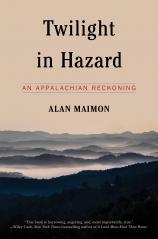Excerpt
Excerpt
Twilight in Hazard: An Appalachian Reckoning

Afterword
Appalachian Kentuckians are understandably sensitive about “outsiders” writing about their home. While the hardcover edition of
Twilight in Hazard received its share of praise in the first year of
release, it also received pushback from some people who felt it
lacked qualities of hope and redemption and spoke too little about
community-level efforts to bring about change. At a book talk on
Main Street in Hazard in July 2021, I heard from several civic leaders who argued that they were experiencing the dawn of a new day, not the sun setting on a previous one. I was also grilled by some audience members on why I didn’t write at greater length about the businesses that have recently opened on and around Main Street. In an opinion piece that ran a few days before the event, Mandi Sheffel, the bookstore owner who kindly hosted me, discussed her journey from opioid addict to entrepreneur. I’m glad she got a forum to tell her incredibly courageous story and am equally pleased that she provided an open forum to discuss my book.
But where does Eastern Kentucky really stand in its economic
development process? The struggles of Appalachian Kentucky were briefly spotlighted in July 2021 when the White House released a series of videos highlighting the region’s water, Wi-Fi, and other woes. The social media campaign had the dual purpose of promoting President Joe Biden’s national infrastructure plan and needling Senate Minority Leader Mitch McConnell for not doing more to help improve living conditions in his home state.
In one of the videos, Martin County, Kentucky, resident Barbi-
Ann Miner’s kitchen faucet spews a stream of murky tap water.
“People talk about ‘Eastern Kentucky is poor and they don’t really have anything,’” Miner says as she drives on her community’s battered roads. “Well, how are we ever going to have anything if our government won’t invest in our infrastructure?”
Though more slickly produced than politically framed messages of decades past, the videos delivered a familiar refrain: Eastern Kentucky is emblematic of an America that has been left behind. The infrastructure bill spurred discussion about strengthening the nation’s core. The bill, it was said, had the potential to bring a level of renewal to Eastern Kentucky not seen since the New Deal era, when the region’s physical, educational, and public health infrastructure all received major boosts. While a massive infusion of federal money into the Eastern Kentucky economy would be welcome, history tells us that that what happens to that money isn’t always the hoped-for panacea. There is the potential pitfall of state and local officials failing to honestly and effectively administer and utilize funds. A former statehouse reporter for the Courier Journal reminded me that Kentucky has a history of waste and corruption when it comes to road building in the eastern part of the state.
It is unfortunate that a legislative companion to the infrastructure bill aimed at expanding the country’s social safety net failed to pass the US Senate in 2021 when Democrat Joe Manchin of West Virginia announced he would use his swing vote in the 50-50 Senate to kill the Build Back Better bill. Failure to pass the bill brought an end to a temporary child tax credit that lifted millions of Americans out of poverty. It would have made a difference to Eastern Kentucky.
Ultimately, government can provide resources and direction, but it is up to stakeholders in Hazard, Harlan, and other Eastern Kentucky towns to devise a plan to address the area’s most pressing challenges. Another year of observing Eastern Kentucky has further convinced me of the value of a jigsaw approach to economic development. No single industry or major project can replace coal, nor should it.
The prison system has tried to fill the void. Eastern Kentucky is
home to three federal correctional facilities, and leaders including Congressman Hal Rogers were pushing hard to build a fourth, which was to be housed on a mountaintop removal site in Letcher County. But the plan was scuttled in 2019, thanks in part to opposition from local activists.
The opening of the Boone’s Ridge nature preserve that I wrote about in Chapter 3 has been delayed to the summer of 2023. The latest transformative idea for the region is a massive solar farm on reclaimed mine land in Martin County.
But the type of development that could have a significant impact is more gradual and won’t make headlines, at least not for a while. It involves establishing a patchwork of different industries: green energy, tech, tourism, agriculture, manufacturing, and the arts. There is reason for optimism on this front. It is inspiring to see the people of the region banding together to give a distinctly local flavor to development. Taking a page from the popular television show “Shark Tank,” a non-profit called Invest 606 has given Eastern Kentucky entrepreneurs, including Sheffel, an opportunity to grow their businesses through training and mentorship.
Geoff Marietta, the founder of Invest 606, has graduate and doctoral degrees from Harvard and an executive background in software development and artificial intelligence. He too is a small business owner who has hopes of revitalizing downtown Harlan with a coffee shop and, more ambitiously, a brewery and restaurant that has drawn significant investment from the local population.
Marietta’s wife’s family ties to Eastern Kentucky prompted them to move there in 2015. He sees similarities between Appalachian Kentucky and the region in the iron mining area of Minnesota that he grew up in. He is a proponent of the build-from-within model. “If you open shop and are waiting for outsiders to come in, you’ll go out of business,” he told me. “You have to build a foundation of livability before you can even think about recruiting outside industries.”
On the ground it’s heartening that people are talking about their future. And I am pleased that Twilight in Hazard has helped contribute to conversations about the past, present, and future of a region seeking to show that its most important natural resource is its people, not its coal, even though, as I write, its price has surged after the United States placed sanctions on Russian coal and oil. I hope this book has helped attack the notion that conditions simply are the way they are there and can never change. Things are most definitely happening there, making the coming years a pivotal time that carries hope of twilight leading to a new day.
Twilight in Hazard: An Appalachian Reckoning
- Genres: Nonfiction, Sociology
- paperback: 304 pages
- Publisher: Melville House
- ISBN-10: 1612199976
- ISBN-13: 9781612199979



